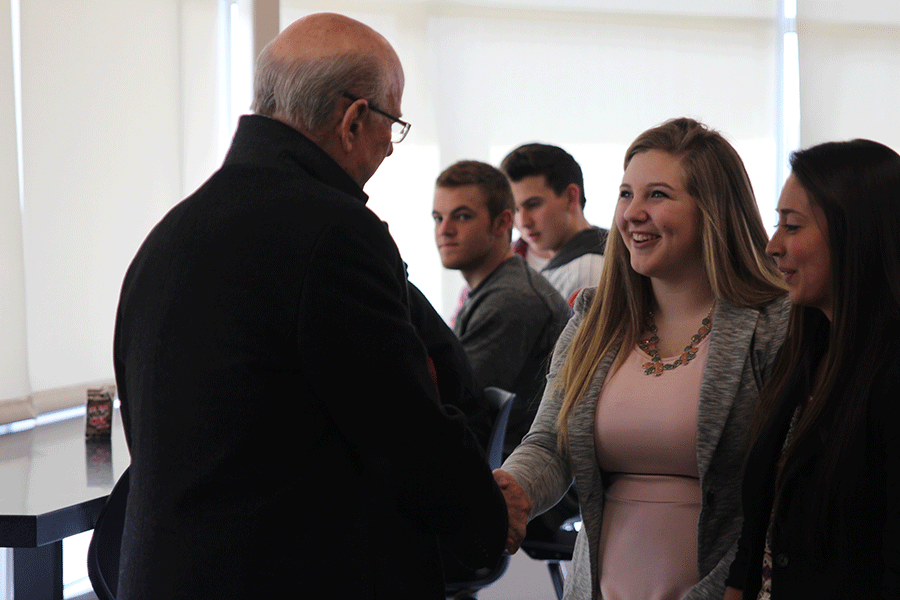U.S. Sen. Pat Roberts visits Mill Valley to assess effectiveness of nutrition standards
Roberts praises nutrition department and The Catty Shack for success under federal guidelines
February 1, 2015
U.S. Sen. Pat Roberts visited the cafeteria and The Catty Shack during lunch on Friday, Jan. 30. He dined with administrators, Advanced Marketing teacher Dianna Heffernon and six students on The Catty Shack’s board of directors to experience lunch at a school that has implemented federal school nutrition standards.
Roberts praised the district’s success in implementing child nutrition regulations.
“That was a great lunch, it was a good meal and here you have a lot of opportunity for choice,” Roberts said.
As the chairman of the Senate’s Agricultural Committee, Roberts will work on legislation to reauthorize federal child nutrition laws that have been in effect since 2012 and are scheduled to expire in September. Roberts is not interested in scrapping the progress made on school lunch; instead, he said the Healthy, Hunger-Free Kids Act of 2010 needs to be flexible for different school districts. He plans to continue to visit lunchrooms across Kansas to see what is working and what regulations may need to be relaxed.
“The act is there. I am not in the business of trying to appeal the act at all,” Roberts said. “Some of the regulations I think we can tweak, some of the regulations we could work with more especially with our smaller rural schools [who] simply cannot afford continuing with this kind of program.”
Director of student nutrition Amy Droegemeier expects change moving forward but does not foresee altering the menu if regulations are relaxed.
“There may be some [relaxations] that we use to our benefit so that we can offer students maybe some of the things they weren’t able to get. One would maybe be breadsticks, we may be able to find a breadstick that we serve occasionally that goes back to the one that we had several years ago, somewhere along those lines,” Droegemeier said. “I listen to those things that kids ask for, ‘I wish we could have,’ those kinds of conversations that we have but I don’t anticipate that we will go backward.”
Although Roberts’ visit was a bit of a surprise, Droegemeier and advanced marketing teacher Dianna Heffernon’s student’s gained some attention last spring when U.S. Department of Agriculture Deputy Undersecretary Dr. Janey Thornton visited and, like Roberts, praised them for successfully implementing the nutrition standards. This is most likely what gained Roberts’ and his team’s attention and make this his first stop.
Senior Ellen Merrill said Roberts was warm in his welcome and asked many questions which relaxed her nerves.
“The Catty Shack marketing department and the cafeteria nutrition work really nicely together and it’s kind of abnormal for a school. We follow all the guidelines so we are able to sell a lot of stuff during school,” Merrill said. “I think he was very impressed that our school is able to do that. Being recognized for that on a national level is really cool.”
Roberts’ visit felt validating for Droegemeier after she worked with the district to balance student preferences and regulations. As a school district with a model lunch program, Droegemeier hopes that they can partner with districts who are still struggling to navigate the regulations so their hard work can also pay off.
Droegemeier attributes the lunchroom’s success to the relationship that the staff and she have made with the students by going to classrooms and talking to kids as they go through the lunch line.
“I know kids have a voice and I want them to feel like they are heard,” Droegemeier said. “We can’t always give the students what they ask for which is the hardest part of my job but I love being able to satisfy at least some of the things students ask us for whether it’s on the menu or a la carte item or just a way of doing things to make their experience positive.”
Roberts’ main concern for the act is over regulation, which makes it difficult for schools to be successful, rural or not. The cost of healthier options, like whole grain pasta and cookies or fresh fruits and vegetables, is a struggle for schools with fewer resources at their disposal. Because of this, Roberts does not expect to be as impressed with meals in other districts.
“This school is tremendous they really do a wonderful job and Amy [Droegemeier] does a super job, she’s on top of it. Probably a young student who comes in here by the time they’re a freshman is eating better,” Roberts said. “There are other schools that simply can’t do this. It becomes a very costly item. There’s a problem of food waste; there’s a national school board study that says the waste is dramatically increased.”
Roberts admits he didn’t eat his entire lunch which consisted of chicken teriyaki bites, brown rice, green beans, pineapple and an apple. Some students, however, complain of hunger and question whether the maximum 850 calories is enough for growing high school students.
“Well I didn’t eat everything on my plate. Some of it was served to me but I think at this school everything is about right,” Roberts said. “From now on I’ll be having lots of school lunches all throughout Kansas. Very small schools, elementary, secondary; I think by the end of it I’ll pretty well have what we can do with the federal regulations to make them more flexible.”
After lunch, students got a chance to show off The Catty Shack. They presented him with a handmade mug and he enjoyed a Jamba Juice, The Catty Shack’s most popular item.
“We got to take pictures with him in front of The Catty Shack and he was really impressed by that so I’d probably say that was the best part being able to show him the catty shack,” Merrill said. “We’re really proud of our school store and that Amy Droegemeier and us are able to correlate so well.”
Pleased with his first stop, Roberts will continue to see how well Kansas school districts are meeting the guidelines and see how the Senate’s Agriculture Committee can change them to fit every districts’ needs.
“You just have to go to the local school level and see what’s actually happening,” Roberts said. “Again this is a showcase effort; they’re all in.”










